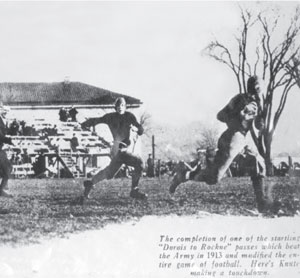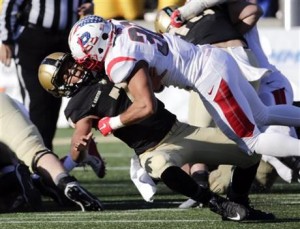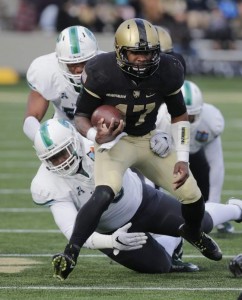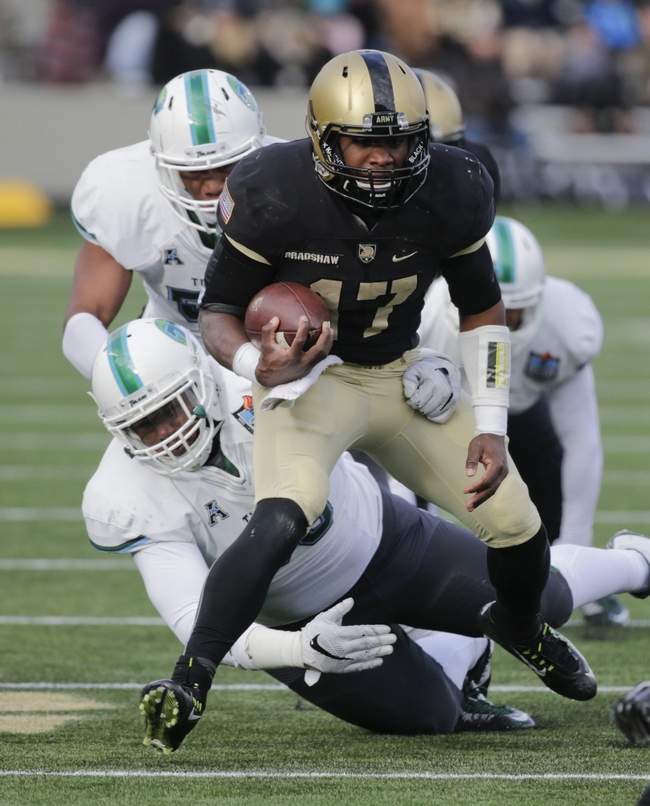The first time Notre Dame and Army met, the Irish made history. This year, Brian Kelly’s team is just hoping for an easy win against a once potent rival. The Irish and Black Knights meet Nov. 12 in San Antonio, Texas, as part of the Shamrock Series.

NYT caption: “Notre Dame’s Knute Rockne, right, scoring on a reception against Army at West Point. Passing was a novelty then, and receivers planted themselves downfield, waiting behind the defense for the roundish ball to arrive.”
MOVING THE GAME FORWARD
Jesse Harper didn’t invent the forward pass, but his 1913 Irish squad was the first to prove it could be successful against top flight talent.
Harry Cross, covering the first Army-Notre Dame clash for the NY Times, captured the shock of Cadet and spectator at the sight of Irish quarterback Gus Dorais whipping the ball downfield.
“The Notre Dame eleven swept the Army off its feet on the Plains this afternoon and buried the soldiers under a 35-to-13 score,” wrote Cross. “The Westerners flashed the most sensational football that has been seen in the East this year, baffling the Cadets with a style of open play and a perfectly developed forward pass which carried the victors down the field 30 yards at a clip. Football men marveled at this startling display of open football. Bill Roper, former head coach at Princeton, who was one of the officials of the game, said that he had always believed that such playing was possible under the new rules but that he had never seen the forward pass developed to such a state of perfection.”
ONE-SIDED AFFAIR
Army and Notre Dame were on each other schedules every year between that first meeting in 1913 and 1947, with the exception of a one-year break during World War I. The Cadets were a formidable opponent, especially in their prime years during World War II. In the modern era, Irish fans have considered each meeting with the Black Knights as an automatic win, with Notre Dame prevailing in the last 16 of 17 contests. The 50th – and last – meeting between the two teams was a 27-3 Irish victory at Yankee Stadium in 2010.
LOOKING BACK, LOOKING AHEAD

Army quarterback Chris Carter (7) is hit by Rutgers defensive back Andre Hunt (30) during the second half of an NCAA college football game on Nov. 21, 2015, in West Point. Rutgers won 31-21. (AP Photo/Mike Groll)
The Black Knights finished 2015 with a staggeringly bad 2-10 record, although eight of those 12 games were within one possession. Army opened with a 2-point loss to FCS-level Fordham, lost by 5 the next week in Connecticut to the Huskies, and then lost to Wake Forest on a last-second field goal. Their wins were against woeful MAC opponent Eastern Michigan (1-11) and Patriot League foe Bucknell (4-7).
Army proved to be one of the worst teams in the Football Bowl Subdivision; their adjusted scoring margin, as calculated by Bill Connelly’s S&P+ metric was negative 20.9 points. Connelly says this is the fifth straight year that number has gotten worse.
If there’s a bright spot for the Knights, it’s that they’re returning a hell of a lot of starters from last year. Army has 78 percent of its team production returning, according to Connelly – 71 percent on offense and 85 percent on defense. That experience could be worth as much as 5 points, Connelly says, which could turn some of last year’s close losses into wins. (For what it’s worth, Connelly is only projecting Army wins 4.6 games this year.)
QB CLASH IS ONE TO WATCH

Army’s Ahmad Bradshaw (Credit: Associated Press)
The competition between sophomore Chris Carter – no, not this guy or this guy or this guy – and redshirt sophomore Ahmad Bradshaw – no, not this guy – may ultimately determine whether the Knights can be competitive and win games. Bradshaw couldn’t stay healthy last year, suffering ankle and shoulder injuries that caused him to miss four games and parts of two others. Carter looked like the stronger, more accurate thrower in his limited attempts, but coughed up the ball more than Bradshaw did during his time on the field.
While Army, Navy and Georgia Tech all run similar triple option attacks, the difference between Army and the other two is the ability to keep defenses honest with the occasional deep completion. The Black Knights simply aren’t able to come up with the big play when it’s needed and that’s kept them from being more successful. If Carter can protect the football – or Bradshaw improve his deep touch – the cadets keep a couple of these marquee games closer than experts predict. (Hopefully not against Notre Dame; the Irish are favored by more than 26 points at present).
WHAT THE EXPERTS SAY
Connelly, SB Nation: “I like the niche Army is carving out with its heavy load of Eastern-seaboard teams (mixed with stops in Texas — ND-Army is in San Antonio this year), and I really liked the [Jeff] Monken hire. That it has taken him a couple of years to get affairs in order makes sense, and even if it was with smoke and mirrors, I think it was a very good sign that Army was able to keep games close and avoid blowouts. But the step after ‘be competitive’ is ‘actually win,’ and Army hasn’t done that. We’ll see if this year is any different.”
Pete Flutak, College Football News: “The pieces are there for this to be the breakthrough campaign. Veteran teams win close games, and this one has the experience. Make the key plays, take advantage of every opportunity, and above all …Beat Navy.”
Eric Murtaugh, One Foot Down: “Army could take a sizable jump forward in Monken’s third year but despite fears that the Irish might not be 100% ready or fatigued from a tough schedule late in the season they should run away with it by the final whistle. The Black Knights just aren’t in the same tier as Navy and the biggest problem for these academies is being able to stop Notre Dame’s offense. Even if it is 17-13 at halftime the game is just as likely to end 48-16 because Army is going to be severely over-matched on defense.”
- In Kelly-Harbaugh Recruit Fight, It’s Tied - January 19, 2017
- Catching Up With Matt Fortuna (Part 2) - January 6, 2017
- Catching Up With Matt Fortuna - January 5, 2017
